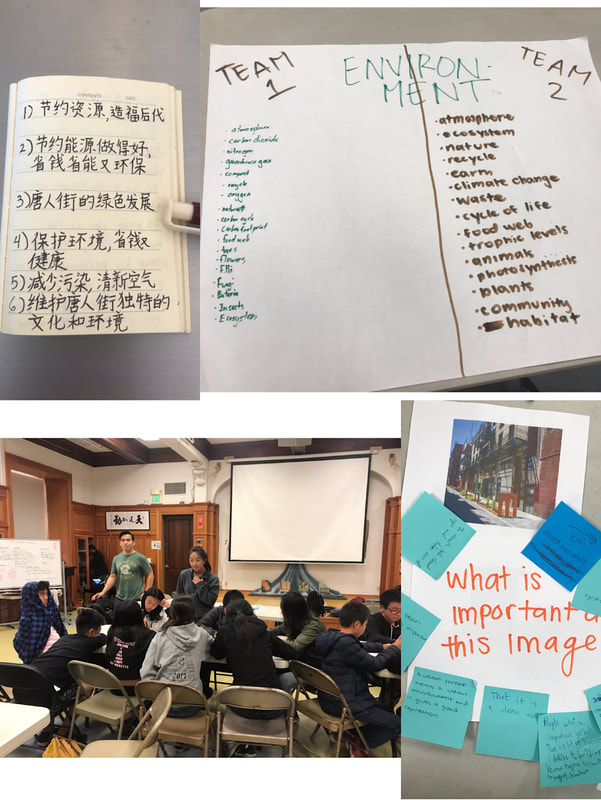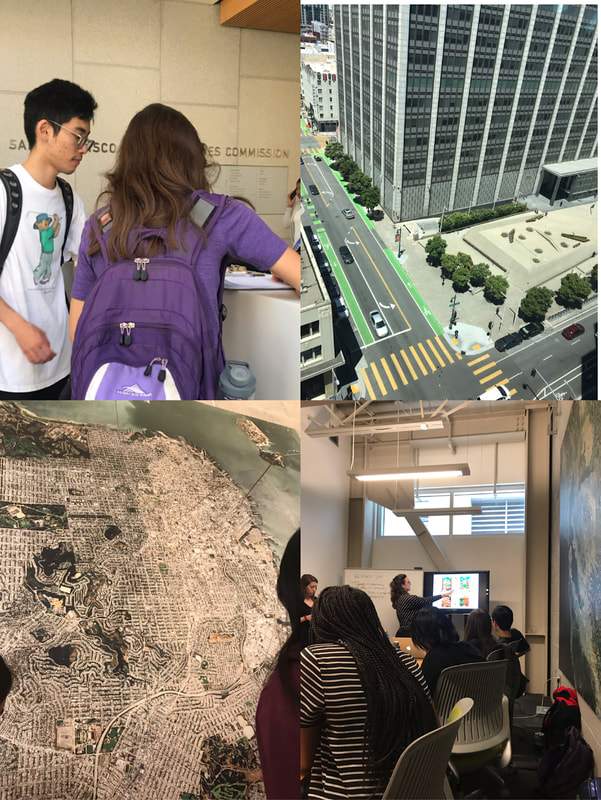|
Everyone was kinda pessimistic about the future Chinatown in the morning because the younger generations are moving out and the cultural aspects of the community will die away. And then in the afternoon in SPUR, we all got more into how the city can actually develop into a place that's more ideal after we did an activity that talked about the spectrum of economic development and social inclusion. -Tianlan
Week 6 mostly consisted of our work on our final projects. We spent a majority of the week out in the streets of Chinatown, attempting to interview seniors (largely in Portsmouth Square) to get their opinions and viewpoints on sustainability and the environment. One lady we were lucky enough to come across, Sarah, was very interesting to talk to because of her willingness to tell us everything she could about what she believed in. Sarah spoke to us as a friend, asking questions about our current lives and imparting her wisdom/advice to us. She felt very strongly that one way to improve our environment was to improve our public transportation. Mandarin, as we were told by Sarah, was essential to many residents of Chinatown in understanding announcements on the bus. We gathered many more responses of different people that helped us understand what community members liked and disliked about Chinatown and what they cared about. These answers helped us in understanding how community members of Chinatown defined their environment and what they were passionate about.
Samantha Hum On Saturday, I attended Waverly Street “Craving Chinatown” Food Festival. It was really nice to witness how the community, both tourists and local community members, gathered to sample foods and be with good company. To participate in the festival and sample foods, you needed to pay fifteen dollars in order to obtain a pass that listed each booth’s items. The pass served as a ticket of sorts- show it to a booth and receive their food item along with a stamp on your pass. You were able to sample the food of 5 booths. My favorite item was the lobster hao gow because I had never eaten hao gow with anything else but shrimp. I also thought it was nice to see that the people working the booths were mostly CYC youth volunteers. Overall, the food festival was a great experience, especially because it promoted the culture of Chinatown in an entertaining way.
Samantha Hum My highlights of week 4 in the Urban Institute program included conversations with Chinatown TRIP, a city hall dome tour, and a meeting with a few UI alumni who are now legislative aids in city hall. Before the day we met a few founders of TRIP, I had never heard of the organization. I was very surprised to learn how crucial they were in improving the public transportation in Chinatown, especially because so many of the community members in the neighborhood rely heavily on bus rides for daily tasks. Yet another example of solidarity and determination to make Chinatown a better place to live in and to be, Chinatown TRIP is an organization I probably never would have learned about if I had not participated in UI.
My favorite part of this week was the City Hall dome tour. I’ve always been amazed at the beautiful architecture of City Hall but I’ve never been able to see the dome, inside and out, in so much detail. It was extremely interesting to hear many fun facts about the dorm and how it was built, such as the role of horse hair in the construction of the dorm. During our time at City Hall we were also able to hear from UI alumni who currently work as legislative aids. Again, I never would have been able to learn about their jobs in the personal and detailed way I did if it weren’t for this program. Samantha Hum Walking into Woh Hei Yuen, my knowledge of Chinatown and its history was limited. I attribute this basic knowledge to my participation in Cameron House and the Presbyterian Church in Chinatown, where it is largely inevitable to spend as much time as I have in these establishments without understanding a little bit about Chinatown’s development, accomplishments, and struggle, both past and present. However, I had never delved more deeply into these stories I’ve been told by various older members of the community: the stories about the I-Hotel, Mei Lun Yuen, Ping Yuen’s, and other establishments or events essential to the understanding of this San Francisco neighborhood. I could recite basic chronological story-lines and main events related to the development and history of Chinatown, but I had far from a comprehensive understanding of causes, effects, and the impacts of certain events on the community. I recognized the historical importance of Chinatown and its incredibly unique background, but I was unaware of many of the efforts to establish the community as the cultural and economic hub that it is today.
I have participated in Chinatown CDC’s Urban Institute Program for two weeks now. Though my knowledge of Chinatown is still limited, with the help of Urban Institute I have begun to chip away at my naïveté and misunderstanding of the neighborhood, unveiling new interests as well as new questions. My interest in Chinatown’s development and community is due to my participation in certain Chinatown developments, and my participation in these programs are due to my grandfather’s history as an immigrant to Chinatown. My grandfather, George Yee, immigrated to San Francisco as a paper son at the age of nine years old. Supporting himself throughout junior high, he worked long hours at a laundromat after school and often ate just gravy and rice during the day before coming home to an SRO. He found solace and community at Cameron House and also began to work odd jobs at the Presbyterian Church in Chinatown on Stockton street. My grandpa never seemed to run out of stories about his experiences in an SRO- ones about the lack of space and subpar living conditions, but also the relationships he forged with other residents. These stories had sparked my interest in SRO’s, but this curiosity was placed in the back of my mind. Because of this, one of my highlights in the Urban Institute Program was our visit to some of the different SRO buildings. Having the opportunity to see the type of conditions my grandfather lived in when he was even younger than I am was eye-opening. The poverty and lack of open space was evident as we looked into various open rooms. But my grandfather spoke of his strong relationships as outweighing his living conditions, and I recognized that though these SRO’s were small, they were still people’s beloved homes and communities. I greatly admire CCDC’s efforts to save the spaces that SRO residents lived in, as well as establish more forms of affordable housing. I’m excited to continue learning about affordable housing efforts, successes, and challenges as we progress in the Urban Institute program. Another highlight was the Chinatown Alleyway Tour given to us by Maggie. I’ve walked through all of the alleyways we talked about multiple times, but I’ve never known about them from a historical perspective. I found Ross alleyway to be the most interesting because of its unexpected ominous history. I learned that Ross alley was notorious for gambling dens and brothels. Today, that history is unrecognizable as the tourist-popular and successful Golden Gate Fortune Cookie Company and other businesses stand in its place. This goes to represent Chinatown’s general history— continuing to be an economic and cultural hub even through adversity. I also found Malcom’s presentations on Chinatown’s economic development and current economic standing very interesting. I knew that businesses and people were being displaced, but I never knew to what extent this displacement had happened/ is happening. Malcom’s presentation and explanations of vacancy rates made me more aware of what is going on in our community. His photographical reports, which included pictures of streets and businesses in the past and in the present, gave a different perspective to the change and continuity of Chinatown. I agree with Malcome when he said, “Chinatown is not dying. Chinatown is under attack.” I look forward to learning even more about this unique neighborhood’s development, accomplishments, and struggles and Chinatown CDC’s Urban Institute looks promising in providing me with new experiences and that information. Samantha Hum The first day of this program was June 18th, but unfortunately, I was in Germany until the 19th. My first day at Chinatown’s CDC was Thursday, June 20th, and I wasn't sure what to expect from the program. We were given a presentation on some of the history of Chinatown as well as the economic development and standings of Chinatown. We discussed the changing dynamics of the neighborhood’s businesses and economy, as well as continuities that are also prevalent in many areas. Overall, my first day at Chinatown CDC’s Urban Institute succeeded in raising new interests and questions of mine, and I look forward to future sessions in which I can learn more.
Samantha Hum The last week of Urban Institute! We began Tuesday’s session with several alumni of the program. Hearing from Alex, Diana, and our other great speaker was genuinely very inspiring. I particularly enjoyed hearing about Diana’s story as her passion was infectious while her personality was incredibly upbeat. I also am interested in the human side of the work that CCDC does in terms of working with residents and their needs. I am a little deterred by working with Chinatown CDC as one of the top requirements is being biliterate l in Cantonese/Mandarin/other languages specific to its residents - which I am not. However, I feel strongly in working in some capacity with direct community involvement/service and UI has really nurtured this desire. This fellowship has solidified this desire and for that I am grateful. After the alumni panel, we were given the rest of the session to work. My group and I worked wonderfully together and we were able to do our last field trip as well as put together our digital archive and powerpoint presentation slides. Our last field trip consisted of a walk to the Chinatown Visitor and Information Center located on 625 Kearny Street, San Francisco, CA 94108. This was my very first time there and I was blown away by the welcoming feel, the cleanliness, abundant resources, and especially the kind and informative woman who received us. After visiting the center, it was clear to us that the issue wasn’t the visitor center itself, but the lack of visibility both in and outside of Chinatown (on the Internet and physically around Chinatown). I am so very proud of our work and can’t wait to showcase it to our special guests on Thursday. After the session ended, Danny and I completed our event observation by helping out in the garden with the CCDC youth team. Here, Danny and I built a new bench for the residents and their young families to enjoy when they visit the garden. This was the first time I've put something together of this size and also the first time using an electrical drill! I felt so accomplished after the construction was complete. There was also a succulent/herb planting workshop and it was refreshing to see young kids/teens genuinely enjoying their friends in the sunshine while they learned about planting. I was so happy to see so many happy children enjoying the food, garden, and even their new bench when we finished! Seeing the direct impact of our actions was really heartwarming and I feel so fortunate to be able to help in any way possible. - Megan Mah |







 RSS Feed
RSS Feed
